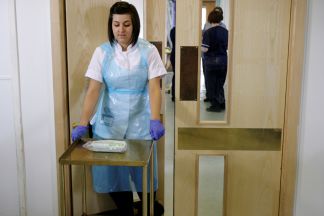
There has been another recent increase in the number of people who have contracted one of the well known Hospital Acquired Infections ( Clostridium Difficile or C.Diff for short ) in a particular North Wales hospital which has lead to an inquiry and headlines again on the issue that just won’t go away for the Health Service.
The overall numbers of patients contracting HAI’s ( sometimes called HCAI’s ) is reported as reducing but the U.K. is still by far one of the Health Services with extremely high rates compared with the worldwide stats. Back in 2007 HCAI deaths included 8,324 from C.Dif and 1593 from MRSA according to Death certificates in the UK where HCAI’S were the cause or the biggest contributory factor to the death.
We employ whole departments of Staff under the banner of Infection Control Nurses who do a marvellous job of training Staff in methods of hygiene and practice which has helped drive down the incidents in recent years.
When did the rot set in? Well according to ( the now Doctor ) Steve Davies of Cardiff University in his Research Paper published in 2009 following his initial 2005 research for UNISON stated that there is a link with the contracting out of hospital cleaning from directly employed NHS Staff to private contractors and the correlation in the hospitals that did contract out found a rise in the rates of MRSA, C.Diff and other HAI’s ( called HCAI’s in Steve’s report ).
In Scandinavian countries and Sweden in particular they have a very disciplined approach to hospital admissions and especially regarding visitors to units and wards. For example a relative wishing to visit a relative in hospital in Sweden has a very short window of opportunity ( a couple of hours at tea-time ) and has to conduct the visit in a day room, the relative doesn’t even get onto the ward, the patient is taken to the visitor, nobody gets to sit on the side of the bed or bring holdalls and bags onto the ward, strict hand hygiene techniques take place for visitors as well as staff and patients and the attitude is based around the avoidance of HAI’s. Compare that Swedish approach with what can happen at a U.K. hospital in some cases. Visiting time is “stretched” across most of the afternoon into early evening, the visit takes place at the bedside, often someone can sit on the bed, bring in a holdall or bag full of food, order a takeaway pizza and have it delivered and this demonstrates how the work of the Infection Control Nurses can be undone or undermined. These are extreme examples but I have checked and they do ring true with a few people.
I have to declare a vested interest in this subject for a number of reasons. Firstly, Dr. Steve Davies is a long standing friend of the family since childhood, secondly I hold a national position in UNISON, thirdly I have tried to raise awareness in my NHS role of this issue and finally the Brighton student I will be referring to in detail at the end of this piece about Design and HAI’s is my daughter. So yes, vested interest.
Last week I attended the Exhibition by 47 final year Product Design Students who go under the collective of Brighton Product Lab.
http://brightonproductlab.wordpress.com/category/blog/
Amongst the great designs for items as far ranging as a brake for your ski, a solar panel with 3 pin plugs connected and other amazing and varied designs there was a theme that was emerging as I walked around the exhibits. That was the theme of trying to save lives, which I felt some resonance with as there were both passive and active elements to the designs. One interesting design was a rear view mirror (electronic eye and tank attached screen) for a motorbike,others that caught my attention included an inhaler for pain relief, pavement illumination for traffic dangers amongst many others. But the reduction of HAI’s featured in 3 of the designs. The use of copper to assist reducing cases directly being passed on by staff to patients featured in only one design, Madeleine Conaghan’s Flo: portable hand sanitising device. It was not so much the copper device that has impressed me, it is the work undertaken by Maddy in learning about HAI, she has attended conferences, met Infection Control teams in London and Sussex, gone to Sweden, met with Steve Davies and persuaded everyone who has read her Staff information posters that HAI’s can be avoided with an increased focus on systematic hand hygiene and thinking about how things are done.
There is a great “5 steps to hand hygiene” initiative now in use in Ambulance Services as we have to be sure that Ambulances and Ambulance Staff are at the forefront of prevention of infection and don’t spread it around from one healthcare environment to another. We didn’t do any studies or randomised trials during the foot and mouth crisis but can you convince me that the farmer’s son thoroughly sprayed the bottom of a 999 Ambulance with disinfectant as it passed the gate when he had called it to the farmhouse as his Dad suffered a heart attack or stroke?
With delays as they are at many Accident and Emergency Units (or E.D.’s as the Medics prefer they are known) we need to raise awareness of infection inside and outside the hospital.
Technology has progressed so much since 1948 when the NHS started and yet microbial copper is still the only touch material that can resist infections as it was all those years ago.
That’s why some hospitals have their trolley sides, sinks/taps, door handles and stair rails made of copper.
http://www.cleanroom-technology.co.uk/news/article_page/French_hospital_uses_copper_to_help_keep_bugs_at_bay/65053
That’s why we need a copper bottomed solution to Health Care Acquired Infections in this country.